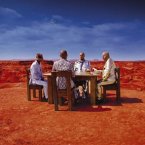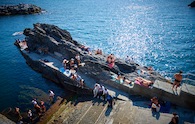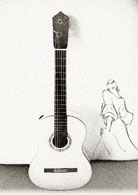Welcome to one of the most active flamenco sites on the Internet. Guests can read most posts but if you want to participate click here to register.
This site is dedicated to the memory of Paco de Lucía, Ron Mitchell, Guy Williams, Linda Elvira, Philip John Lee, Craig Eros, Ben Woods, David Serva and Tom Blackshear who went ahead of us.
We receive 12,200 visitors a month from 200 countries and 1.7 million page impressions a year. To advertise on this site please contact us.
|

|
|
flamenco arpeggio
|
You are logged in as Guest
|
|
Users viewing this topic: none
|
|
Login  | |
|

   
Miguel de Maria
Posts: 3532
Joined: Oct. 20 2003
From: Phoenix, AZ

|
 RE: flamenco arpeggio (in reply to rickm) RE: flamenco arpeggio (in reply to rickm)
|
|
|
Try this one, put your little finger on the 3rd fret, 2nd string, ring finger on the 3rd fret 3rd string. Keep these fingers there. Now place the 2nd finger on the 3rd fret, 4th string and using that as a bass note, do a pimami. Now remove the 2nd finger and put the first finger on the 2nd fret, fourth string, do a pimami. Now remove the finger and play the open string there, pimami. Now play the third fret, fifth string.
This is something you can use in tangos, solea, or other palos while playing "por medio."
|
|
|
|
REPORT THIS POST AS INAPPROPRIATE |
Date Aug. 17 2004 15:38:33
 |
|

   
Ron.M
Posts: 7051
Joined: Jul. 7 2003
From: Scotland

|
 RE: flamenco arpeggio (in reply to rickm) RE: flamenco arpeggio (in reply to rickm)
|
|
|
I think you are viewing arpegio too much from a Classical Guitar point of view here.
Arpegio in Flamenco, is merely a bit of ornamentation. Nothing more.
If, say, you have a bass line and there are three strings above the string your thumb is on, then, if you want, you can play a forward, backwards or complete arpegio... whatever you feel like.
If you only have 2 strings above the bass string, then you may play an i-m-i triplet or alzapua with the index finger coming up.
Since Flamenco guitar music is composed on the guitar, it's all about "opportunism".
There are no rules in this area.
For example it is commonplace these days to here a quick little forward arpegio leading into a bit of picado.
You won't hear that on older recordings, since nobody did that back then.
Flamenco gives the player great freedom of choice.
So long as the end result is in compás and has the right "flavour" or aire, then it's good.
Now *that's* the hard part! 
(All the above of course are only my own opinions and conclusions based on my own experience, so don't take it as gospel!)
cheers
Ron
|
|
|
|
REPORT THIS POST AS INAPPROPRIATE |
Date Aug. 17 2004 17:13:38
 |
|

   
Jon Boyes
Posts: 1377
Joined: Jul. 10 2003

|
 RE: flamenco arpeggio (in reply to rickm) RE: flamenco arpeggio (in reply to rickm)
|
|
|
OK, I think I see what you mean now. I would simply call them arpeggio licks - yes, there are common ones that crop up all the time, and that are native to a particular palo. Solea is good for these as there's plenty of time to twiddle around on the chords between the changes.
I wouldn't bother analaysing them to see what chords are being suggested by the extra notes though, they are just really passing embellishments as Ron says.
I think your best bet would just be to get your hands some 'old school' flamenco material (books and tabs) and listen to different players and you will soon see and hear common arpeggio licks. Paco Penas Toques Flamencos has plenty of them, Juan Serrano is also fond of twiddly arpeggios. Listen also to Sabicas, Montoya etc.
There is no 'standard study' for these little licks, you just need to listen a lot and pick out the ones you like. Assuming you are familiar with the basic chord progressions of the palos, you can make your own up too, just use your ears to decide what sounds cool, there are no rules providing you stay in compas.
I don't think searching for a classical guitar study is your answer. There are hundreds of aepeggio studies in the CG repertoire, and they are often designed around a particular shape (eg Carcassi Opus 60 #3 is great for PIMA), but the goals in classical guitar music are very different. You won't really find all those little embellishments that you do in flamenco, or at least not to the same extent and not played in the same way.
Much better just to dig out falsetas from old school flamenco that have the patterns you want, string them together and use them as studies.
Jon
|
|
|
|
REPORT THIS POST AS INAPPROPRIATE |
Date Aug. 18 2004 11:06:50
 |
|

   
Escribano
Posts: 6418
Joined: Jul. 6 2003
From: England, living in Italy

|
 RE: flamenco arpeggio (in reply to rickm) RE: flamenco arpeggio (in reply to rickm)
|
|
|
Do as I say, not as I do 
For what it is worth and having no idea of your level (there are no such thing as levels in flamenco anyway, you can either do it after many hours of practise, or you are not practising  ), if you want arpeggios like the ones I am using here (please ignore the wayward compás and many mistakes): ), if you want arpeggios like the ones I am using here (please ignore the wayward compás and many mistakes):
http://www.foroflamenco.com/upfiles/1/Vt56894.mp3
I taught myself (after some lessons in London and Granada) and followed on with the basics from Manuel Granados Flamenco guitar didactic handbook. Vol. 1 & 2
https://www.flamenco-world.com/tienda/shop.php?&vshopferca=2571a5ab2abfd3e304daccddb1d3082f&op_shop=show&id_prod=38&id_cat=
He also includes some very good practise regimes but beware his levels accelerate overnight!
The rest are from tabs of Paco Pena, Pepe Habechuela, Paco De Lucia and Carlos Montoya from the web.
If they are no good for you, then it's my playing  technically they are basically novice. technically they are basically novice.
Crisp arpeggios (6 to the beat or more) are really hard to master but a sign of a good player.
It is very hard to recommend a piece below intermediate level. I would suggest the standard work of Paco Peña - Toques flamencos (used as part of the entry exam into the Madrid Conservatoire).
https://www.flamenco-world.com/tienda/shop.php?&vshopferca=7ff1bb71a2bded3d079ecbf4e096a18b&op_shop=show&id_prod=823&id_cat=
This is intermediate level but worth working up to.
The standard arpeggios nearly always work on the chord you are holding at the time, with (usually) no legado e.g. E, Am or D using the fingering of p-i-m-a-m-i in one beat. p is playing the bass usually on the 6th, 5th or 4th string (depending on key), then i-m-a-m-a on 3rd-2nd-1st-2nd-3rd strings respectively. Some use 4th-3rd-2nd-3rd-4th and then all sorts of variations.
I find the simpler p-i-m-a with no descent even more difficult to time well. It is harder to play more simply but well. Arpeggios are mere baubles after all, for embellishment when the singer is not singing (and flamenco is all about the singing) - too much bling is often worse than not doing it all (something a lot of us are very guilty of). Another factor in fancy arpeggios is that they cannot be heard in the average pena anyway 
Another arpeggio rule that occurs to me is the i on the open 1st string, it's nearly always there in counter-point at the end of a bar or phrase. As Ron says, an upward arpeggio will often lead into a downward picado and compás is God. One should take the simplest flamenco in compás than all the bling in the world. Now to live by my own advice.
This only two years of trying to figure it out and I take no responsibility for the accuracy of this post but I hope it helps.
_____________________________
Foro Flamenco founder and Admin
|
|
|
|
REPORT THIS POST AS INAPPROPRIATE |
Date Aug. 25 2004 19:15:42
 |
|
 New Messages New Messages |
 No New Messages No New Messages |
 Hot Topic w/ New Messages Hot Topic w/ New Messages |
 Hot Topic w/o New Messages Hot Topic w/o New Messages |
 Locked w/ New Messages Locked w/ New Messages |
 Locked w/o New Messages Locked w/o New Messages |
|
 Post New Thread
Post New Thread
 Reply to Message
Reply to Message
 Post New Poll
Post New Poll
 Submit Vote
Submit Vote
 Delete My Own Post
Delete My Own Post
 Delete My Own Thread
Delete My Own Thread
 Rate Posts
Rate Posts
|
|
|
Forum Software powered by ASP Playground Advanced Edition 2.0.5
Copyright © 2000 - 2003 ASPPlayground.NET |
6.054688E-02 secs.
|


 Printable Version
Printable Version











 New Messages
New Messages No New Messages
No New Messages Hot Topic w/ New Messages
Hot Topic w/ New Messages Hot Topic w/o New Messages
Hot Topic w/o New Messages Locked w/ New Messages
Locked w/ New Messages Locked w/o New Messages
Locked w/o New Messages Post New Thread
Post New Thread